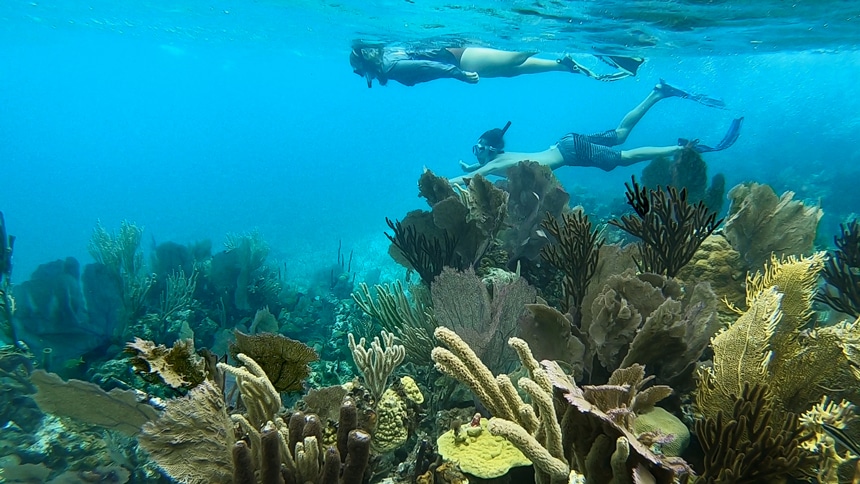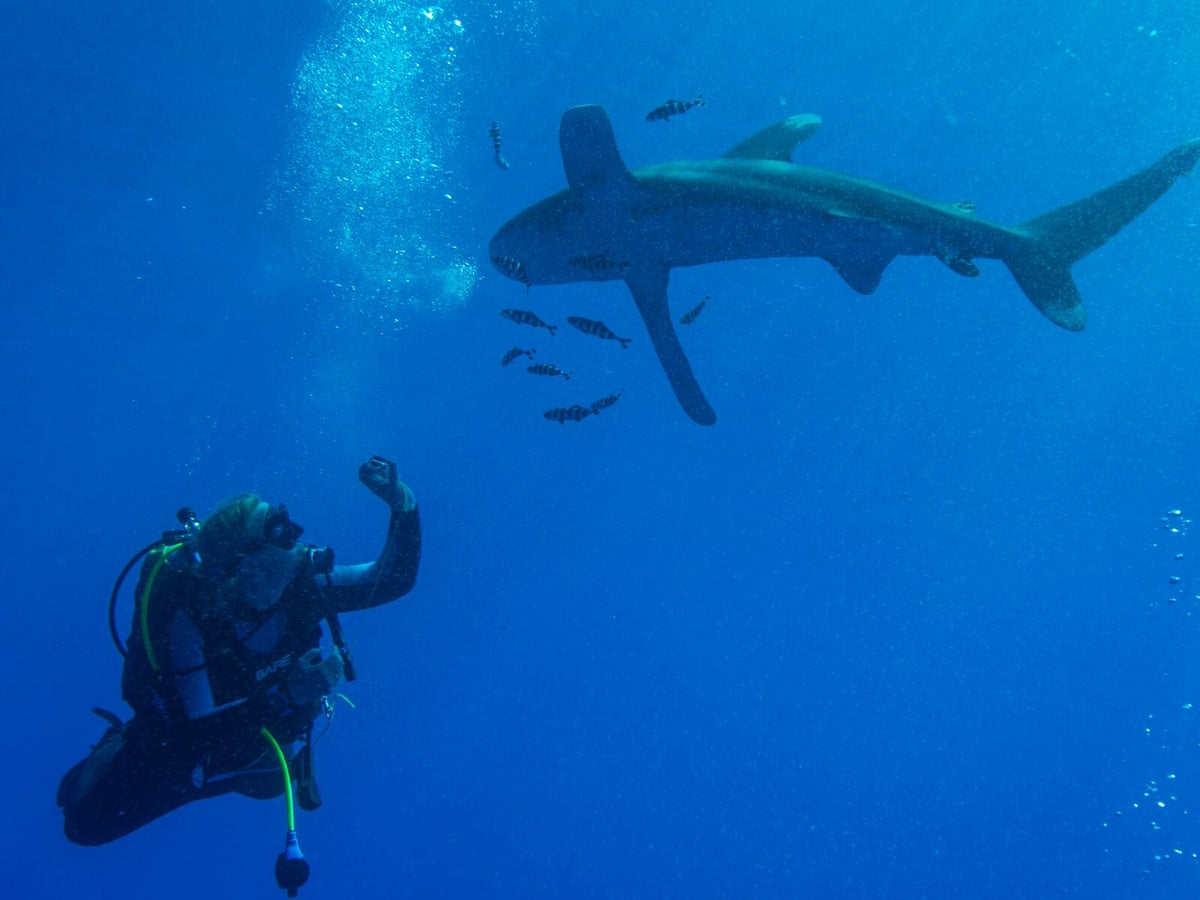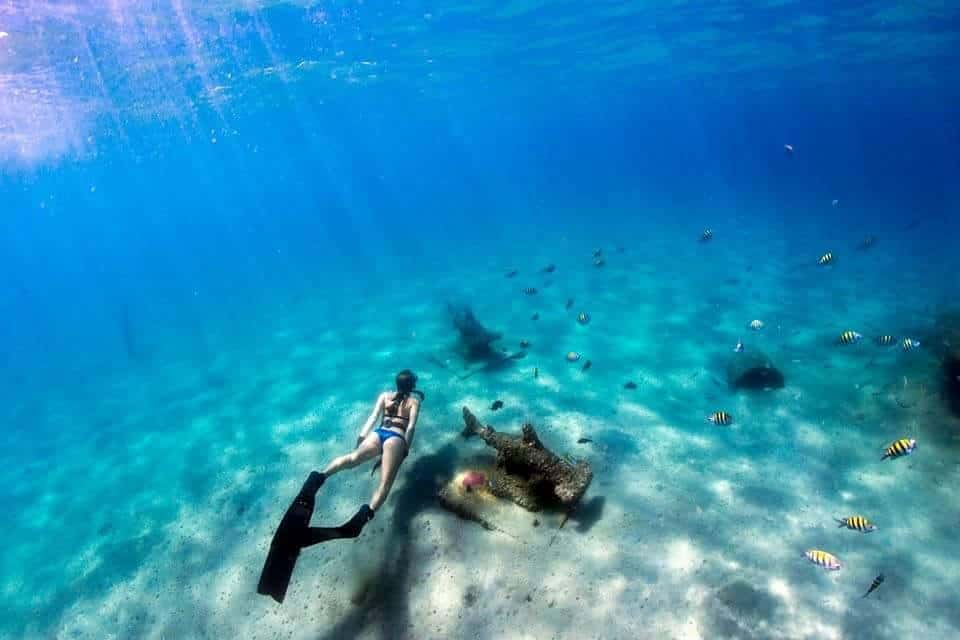The Best Time of Year to Go Snorkeling in the Red Sea
As an adventurer and nature lover, there's nothing quite as exhilarating as exploring the underwater world. And an experience that stands above all others is snorkelling in the Red Sea. With crystal-clear waters teeming with vibrant and diverse marine life, it's a diving destination that should be on every traveller's bucket list.
However, planning the perfect snorkelling trip requires research and knowing the best time to visit. In this blog post, we'll explore the best time of year to go snorkelling in the Red Sea so that you can make the most out of your vacation. So, sit back, relax, and let's dive in!

Introduction
Explanation of snorkelling in the Red Sea
Snorkelling in the Red Sea is a truly remarkable experience for water enthusiasts. With its crystal-clear waters, vibrant coral reefs, and diverse marine life, the Red Sea offers a one-of-a-kind snorkelling adventure.
The Egyptian Riviera, stretching along the west coast of the Gulf of Aqaba and the Gulf of Suez, is one of the most popular snorkelling destinations in the world. From Taba to Marsa Alam, plenty of resorts and beaches exist to explore.
In the Red Sea, you will have the opportunity to encounter an array of marine creatures, from colourful clownfish and angelfish to sea turtles, dolphins, and even the elusive dugong. The waters are teeming with biodiversity, with over 200 species of corals, 1,200 species of fish, and 1,000 species of invertebrates calling the Red Sea home.
The best time to snorkel in the Red Sea is during the late spring, early summer and autumn months. During this time, the water temperature is pleasantly warm, and the air is comfortable for outdoor activities. However, it is important to consider the water temperatures and weather conditions when planning your trip.
While snorkelling in the Red Sea offers incredible marine life sightings, it is also important to be aware of crowded beaches and dive sites and higher prices for accommodation and activities during peak seasons. If you prefer a quieter experience with fewer crowds and more affordable options, consider visiting during the shoulder seasons. However, remember that unfavourable weather conditions and fewer opportunities to see certain marine life may be possible during these times.
To ensure a memorable snorkelling trip in the Red Sea, it is recommended to plan your trip well in advance and choose the right time of year based on your preferences and priorities. Whether you are a beginner snorkeler or an experienced water explorer, snorkelling in the Red Sea is an adventure you do not want to miss. [1][2]

Importance of choosing the right time of year
When it comes to snorkelling in the Red Sea, choosing the right time of year is crucial. This is because the weather conditions can greatly impact your snorkelling experience. Snorkelling is enjoyable and safe, but it becomes even more so when you pick the ideal time to dive in.
Water Temperature and Precipitation
One of the key factors to consider is the temperature and precipitation throughout the year. The water is the warmest from May to December, making it the best time for snorkelling. However, the water temperature remains pleasant even during the rest of the year, typically in the low 70s.
Water Roughness
Another important aspect to consider is the water's roughness, which factors like wind and waves can influence. Calm wind and mild waves provide more comfortable conditions for snorkelling. On the other hand, strong winds and high waves can make snorkelling difficult, affecting your safety and visibility.
Marine Life
Furthermore, the best time to see marine life in the Red Sea is during the summer season, from May to October. During this period, you can spot dolphins, turtles, giant groupers, and colourful reef fish. However, if you prefer to avoid crowded beaches and dive sites, it's advisable to plan your trip during the off-peak season, particularly from December to February.
Off-Peak Season
While reduced crowds and lower prices are advantages of travelling during the off-peak season, it's important to note that there may be some drawbacks. Unfavourable weather conditions and fewer opportunities to see certain marine life can be factors to consider.
Conclusion
Choosing the right time of year for snorkelling in the Red Sea is essential to ensure a memorable and enjoyable experience. You can plan your trip by considering factors such as water temperatures, marine life sightings, crowdedness, and prices. So, pack your snorkelling gear and get ready to explore the wonders of the Red Sea! [3][4]

Weather conditions in the Red Sea
Overview of temperature and precipitation throughout the year
The Red Sea is a popular destination for snorkelling, thanks to its warm temperatures and clear waters. Throughout the year, the water temperature remains relatively constant at around 77°F/25°C, making it comfortable for snorkelling. The Red Sea experiences a tropical climate, with day temperatures ranging from 22°C (71°F) in January to 37°C (99°F) in August. The warm temperatures help promote coral reef growth, providing a habitat for a diverse array of marine life.
Regarding precipitation, the Red Sea region has a relatively dry climate. The driest month is July, with no rain, while January sees an average of one day of rain. Visitors can expect plenty of sunny days, making it perfect for snorkelling adventures.
It's important to note that the best time to visit the Red Sea is between March and December. During this period, the temperatures are between 24°C (75°F) and 37°C (99°F), with an average of 0 days of rain per month. The sea temperature ranges from 22°C (72°F) to 28°C (83°F), ideal for snorkelers.
While the Red Sea offers great snorkelling opportunities year-round, it's essential to consider the weather conditions and plan accordingly. The reduced crowds and lower visiting prices during the off-peak season can be advantageous. However, there might be a possibility of unfavourable weather conditions, and certain marine life may be less visible.
The Red Sea is a fantastic destination for snorkelling, with its warm temperatures and clear waters. Snorkelers can enjoy optimal conditions and a diverse range of marine life by choosing the right time of year to visit. [5][6]

Importance of considering water temperatures
When planning a snorkelling trip to the Red Sea, it is important to consider the water temperatures.
While many might think that sunny weather and calm waters are the perfect conditions for snorkelling, other factors come into play. The Red Sea boasts warm water temperatures year-round, ideal for marine life. The warm water promotes the growth of coral reefs, providing a habitat for a diverse array of fish and other marine animals. Additionally, the clear visibility in the Red Sea makes it easy to see the colourful coral reefs and the multitude of marine life that call it home.
However, choosing the right time of year to experience the best water temperatures for snorkelling is crucial. Water temperatures in the Red Sea typically range from 78°F to 79°F (25°C to 26°C). For beginners, the best time to go snorkelling is from July to November, while advanced divers can enjoy snorkelling all year round. It is important to note that water temperatures can vary depending on the season. From December to February, water temperatures are cooler, making them less ideal for snorkelling.
Considering water temperatures is essential for a comfortable and enjoyable snorkelling experience. By choosing the right time of year, snorkelers can immerse themselves in the vibrant marine life of the Red Sea while experiencing pleasant water temperatures. So, before planning your snorkelling trip, make sure to take into account the water temperatures during your desired travel dates. [7][8]
High season in the Red Sea
Best time to see marine life
One of the most exciting aspects of snorkelling in the Red Sea is seeing diverse marine life. Choosing the right time of year for your snorkelling adventure is important to maximise your chances of encountering vibrant underwater species.
The best time to see marine life in the Red Sea is during the spring (March–May) and fall (September–November) seasons. During these periods, the water is still warm and accessible, making it perfect for snorkelling. Whether you're exploring the Red Sea or the Mediterranean Sea, you'll be amazed by the abundance of marine creatures waiting to be discovered.
Popular snorkelling sites such as El Gouna, Hurghada, Marsa Alam, El Quseir, and Sharm El Sheikh offer opportunities to encounter dolphins, turtles, giant groupers, and shoals of colourful fish. The Ras Mohammed National Marine Park is renowned for its extraordinary coral garden and rich biodiversity. Vertical walls, nutrient-laden currents, and 700-meter-deep reefs have created a perfect habitat for various marine fauna.
While some marine life can be seen year-round, such as grey reef sharks, dolphins, and dugongs, there are specific seasons for spotting other species. For example, whale shark season occurs from the end of May until the end of July, when plankton blooms attract manta rays and nesting turtles. Hammerhead sharks can be seen throughout the Red Sea, while the winter months (December–February) are best for spotting the elusive Thresher Shark.
By planning your snorkelling trip during the best time to see marine life, you'll have the opportunity to witness these incredible creatures in their natural habitat. Remember to choose a time when dive sites are less crowded, such as avoiding the high season from July to December, for a more intimate and unforgettable underwater experience. [9][10]
Crowded beaches and dive sites
When planning a snorkelling trip to the Red Sea, it is important to consider the time of year you will be visiting. One factor is the crowding level at the beaches and dive sites. Avoiding the high season from July to December is best if you prefer a more tranquil experience in the water. During this time, popular tourist destinations can become crowded with holidaymakers worldwide.
However, visiting during the high season can still offer a great snorkelling experience if you do not mind the hustle and bustle. Remember that certain marine life, such as grey reef sharks, dolphins, and dugongs, can be spotted year-round in the Red Sea. So, even during the peak tourist season, you will still have opportunities to encounter these fascinating creatures underwater.
Aside from the crowded beaches and dive sites, another aspect to consider is the pricing for accommodation and activities. During the high season, prices tend to be higher, reflecting the increased demand. If you are travelling on a budget, it might be worth visiting during the shoulder or low seasons when prices are typically more affordable. However, remember that during these times, there might be fewer opportunities to see certain marine life and the possibility of unfavourable weather conditions.
In conclusion, while the high season may offer crowded beaches and dive sites, having a fantastic snorkelling experience in the Red Sea is still possible. Consider your preferences and budget when deciding on the best time to plan your trip. Whether you visit during the peak season or opt for a quieter period, the Red Sea's rich marine life and stunning coral reefs will leave you awe-inspired. [11][12]
High prices for accommodation and activities
Planning a trip to snorkel in the Red Sea can be an amazing experience. However, it is important to consider the high prices for accommodation and activities during certain times of the year. This is especially true during the peak tourist season when prices tend to be higher due to the high demand.
Popular tourist destinations such as Hurghada and Sharm el-Sheikh can be crowded with tourists worldwide during this time. The beaches and dive sites can be packed, making finding a quiet spot to snorkel challenging.
Additionally, accommodation prices tend to skyrocket as hotels exploit the increased demand. Finding affordable accommodation can be difficult, from luxury resorts to budget options.
Furthermore, boat tours and excursions may also have a higher price tag. These activities allow exploring different snorkelling spots and marine life, but it is important to budget accordingly.
Planning your trip during the off-peak seasons is best to avoid crowds and save money on accommodation and activities. This includes the late spring-early summer, and autumn months. During these times, the weather is still pleasant, the water temperature is warm, and there are fewer tourists.
However, it is important to note that unfavourable weather conditions can occur during the off-peak seasons. Storms and high waves may limit snorkelling opportunities, so checking the weather forecast before planning your trip is essential.
Additionally, certain marine life may not be as prevalent during the off-peak seasons. It is important to research and understands which marine species you want to see and when they are most likely present.
Overall, planning a trip to snorkel in the Red Sea requires careful consideration of the high prices for accommodation and activities and the pros and cons of visiting during the peak and off-peak seasons. With the right planning, you can have a fantastic snorkelling experience while saving money. [13][14]

Low season in the Red Sea
Reduced crowds and lower prices
One of the major benefits of visiting the Red Sea for snorkelling during the off-peak seasons is the reduced crowds and lower prices. The low tourist season in Egypt typically occurs from June to August and December to February. During these months, the number of tourists visiting the Red Sea region is significantly lower compared to the peak season. This means you can enjoy the beaches and dive sites with fewer people, allowing for a more enjoyable and tranquil experience.
Not only will you have more space to yourself, but you'll also find that prices for accommodation and activities are much more affordable during the low tourist season. Hotels and resorts often offer discounted rates to attract visitors during this time, which means you can enjoy a budget-friendly trip without compromising the quality of your stay.
Considerations
However, it's important to note that visiting during the off-peak season comes with a few considerations. Firstly, the weather may not be as optimum as during the peak season, and you may encounter some unfavourable conditions, such as occasional rain or sandstorms. Additionally, you might have fewer opportunities to see certain marine life, as some species may migrate or be less active during these months.
Planning ahead
To make the most of your snorkelling trip to the Red Sea during the off-peak season, it's recommended to plan and book your accommodations and activities in advance. This way, you can secure the best deals and ensure a smooth and enjoyable experience.
With reduced crowds and lower prices, visiting the Red Sea during the low tourist season can be a fantastic opportunity for an unforgettable snorkelling adventure. [15][16]

Possibility of unfavourable weather conditions
When planning a snorkelling trip in the Red Sea, it is important to consider the possibility of unfavourable weather conditions. While snorkelling is possible year-round in the Red Sea, the weather can change instantly, affecting the water's roughness and safety, especially if you are not a strong swimmer.
Wind and waves can impact your snorkelling experience. Wind can stir up sediments and create less visibility, while large waves can make snorkelling difficult and even dangerous.
It is also crucial to consider other weather conditions like rain and tides. Snorkelling in a drizzle is usually not a problem, but heavy rain can reduce visibility and create unsafe situations. Similarly, tides can impact ocean conditions, affecting wave and wind activity, visibility, and overall safety. Planning your snorkelling sessions according to the tide times can help ensure a smoother and safer experience.
While the Red Sea region generally enjoys warm temperatures and clear waters, it is crucial always to follow weather forecasts and stay updated on the hourly wind, rain, and wave conditions. Additionally, be aware of your snorkelling abilities and confidence level in the water. Choosing calm and clear conditions for the best snorkelling experience is always recommended.
By considering the possibility of unfavourable weather conditions and planning your trip accordingly, you can maximize your enjoyment and safety while snorkelling in the Red Sea. [17][18]

Fewer opportunities to see certain marine life
When planning a snorkelling trip to the Red Sea, it is important to consider the time of year to maximise your chances of experiencing marine life to its fullest.
The Red Sea is known for its abundance of marine life, but there are certain times of the year when you may have fewer opportunities to see specific species.
For example, the best time to see marine life, such as sea turtles, dugongs, and dolphins, is during the warmer months, from May to September. These months offer the perfect conditions for these creatures to thrive and can provide unforgettable encounters. However, it is important to note that these warmer months can also bring in larger crowds of tourists, which may impact your overall snorkelling experience.
On the other hand, if you are looking for fewer crowds and lower prices, the cooler months from January to April and October to December offer a quieter atmosphere. However, certain marine species may be less active during these months or even migrate to different areas. So while you may have less competition for space in the water, you may also have fewer opportunities to encounter certain marine life.
When planning your snorkelling trip to the Red Sea, it is essential to weigh the pros and cons of each season. Consider the type of marine life you are most interested in seeing and balance it with your desire for a more peaceful and budget-friendly experience. With proper planning and research, you can make the most of your trip and have a fantastic snorkelling adventure in the Red Sea. [19][20]

Recommendations for planning a trip.
When planning a trip to snorkelling in the Red Sea, there are a few things to keep in mind to ensure a memorable and enjoyable experience.
Timing
The best time to snorkel in the Red Sea is during the late spring-early summer (May to end of June) or in autumn (mid-September to November). During these months, the water temperatures are pleasant, and the air temperatures are comfortable, ranging from 26-35°C.
Destination
Many popular tourist destinations in the Red Sea offer great snorkelling opportunities. Hurghada, Sharm El Sheikh, Marsa Alam, and Dahab are all good options. When choosing a destination, it is important to consider your interests and preferences. For example, if you are interested in seeing a wide variety of marine life, Marsa Alam is a good choice. Dahab may be a better option if you are looking for a more relaxed and peaceful experience.
Accommodation
If snorkelling is the main focus of your trip, then it is important to choose an accommodation with good access to house reefs. These reefs are located close to shore and easily accessible from the beach. Some hotels in Hurghada have sandy beaches with limited marine life, so booking accommodations in Makadi Bay, Sahl Hasheesh, or Soma Bay, where you can access house reefs, is advisable.
Other considerations
Another important consideration is the cost of travel and accommodation. The Red Sea is a popular tourist destination so prices can be high during the peak season. If you are on a budget, visiting during the shoulder seasons (April-May and September-October) is best.
Finally, it is important to know the potential for unfavourable weather conditions. The Red Sea is a tropical region, so rain or wind is always possible. Checking the weather forecast before making your travel plans is a good idea.
By following these recommendations, you can have an amazing snorkelling adventure and witness the stunning marine life of the Red Sea. [21][22]
